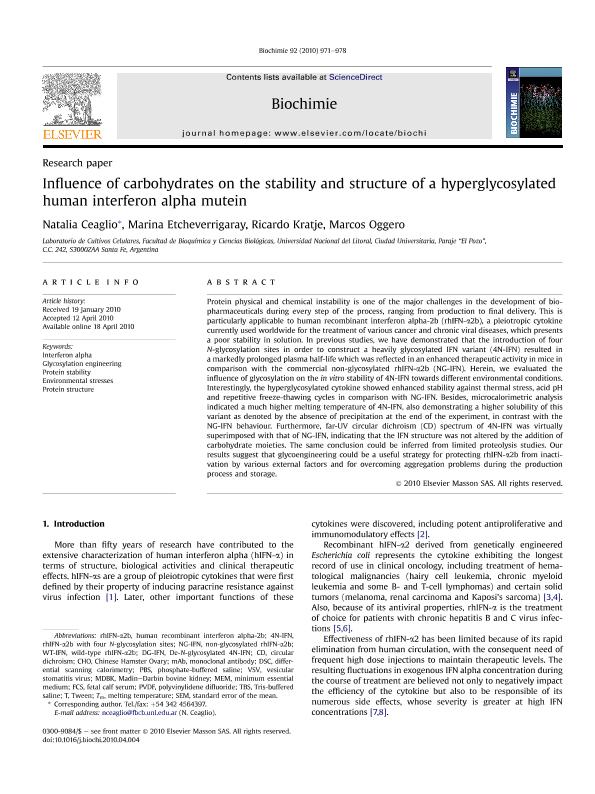Mostrar el registro sencillo del ítem
dc.contributor.author
Ceaglio, Natalia Analia

dc.contributor.author
Etcheverrigaray, Marina

dc.contributor.author
Kratje, Ricardo Bertoldo

dc.contributor.author
Oggero Eberhardt, Marcos Rafael

dc.date.available
2020-02-14T19:55:15Z
dc.date.issued
2010-08
dc.identifier.citation
Ceaglio, Natalia Analia; Etcheverrigaray, Marina; Kratje, Ricardo Bertoldo; Oggero Eberhardt, Marcos Rafael; Influence of carbohydrates on the stability and structure of a hyperglycosylated human interferon alpha mutein; Elsevier Masson; Biochimie; 92; 8; 8-2010; 971-978
dc.identifier.issn
0300-9084
dc.identifier.uri
http://hdl.handle.net/11336/97613
dc.description.abstract
Protein physical and chemical instability is one of the major challenges in the development of biopharmaceuticals during every step of the process, ranging from production to final delivery. This is particularly applicable to human recombinant interferon alpha-2b (rhIFN-α2b), a pleiotropic cytokine currently used worldwide for the treatment of various cancer and chronic viral diseases, which presents a poor stability in solution. In previous studies, we have demonstrated that the introduction of four N-glycosylation sites in order to construct a heavily glycosylated IFN variant (4N-IFN) resulted in a markedly prolonged plasma half-life which was reflected in an enhanced therapeutic activity in mice in comparison with the commercial non-glycosylated rhIFN-α2b (NG-IFN). Herein, we evaluated the influence of glycosylation on the in vitro stability of 4N-IFN towards different environmental conditions. Interestingly, the hyperglycosylated cytokine showed enhanced stability against thermal stress, acid pH and repetitive freeze-thawing cycles in comparison with NG-IFN. Besides, microcalorimetric analysis indicated a much higher melting temperature of 4N-IFN, also demonstrating a higher solubility of this variant as denoted by the absence of precipitation at the end of the experiment, in contrast with the NG-IFN behaviour. Furthermore, far-UV circular dichroism (CD) spectrum of 4N-IFN was virtually superimposed with that of NG-IFN, indicating that the IFN structure was not altered by the addition of carbohydrate moieties. The same conclusion could be inferred from limited proteolysis studies. Our results suggest that glycoengineering could be a useful strategy for protecting rhIFN-α2b from inactivation by various external factors and for overcoming aggregation problems during the production process and storage.
dc.format
application/pdf
dc.language.iso
eng
dc.publisher
Elsevier Masson

dc.rights
info:eu-repo/semantics/openAccess
dc.rights.uri
https://creativecommons.org/licenses/by-nc-nd/2.5/ar/
dc.subject
ENVIRONMENTAL STRESSES
dc.subject
GLYCOSYLATION ENGINEERING
dc.subject
INTERFERON ALPHA
dc.subject
PROTEIN STABILITY
dc.subject
PROTEIN STRUCTURE
dc.subject.classification
Otras Biotecnologías de la Salud

dc.subject.classification
Biotecnología de la Salud

dc.subject.classification
CIENCIAS MÉDICAS Y DE LA SALUD

dc.title
Influence of carbohydrates on the stability and structure of a hyperglycosylated human interferon alpha mutein
dc.type
info:eu-repo/semantics/article
dc.type
info:ar-repo/semantics/artículo
dc.type
info:eu-repo/semantics/publishedVersion
dc.date.updated
2020-02-13T18:53:19Z
dc.journal.volume
92
dc.journal.number
8
dc.journal.pagination
971-978
dc.journal.pais
Francia

dc.journal.ciudad
Paris
dc.description.fil
Fil: Ceaglio, Natalia Analia. Consejo Nacional de Investigaciones Científicas y Técnicas. Centro Científico Tecnológico Conicet - Santa Fe; Argentina. Universidad Nacional del Litoral. Facultad de Bioquímica y Ciencias Biológicas. Laboratorio de Cultivos Celulares; Argentina
dc.description.fil
Fil: Etcheverrigaray, Marina. Universidad Nacional del Litoral. Facultad de Bioquímica y Ciencias Biológicas. Laboratorio de Cultivos Celulares; Argentina. Consejo Nacional de Investigaciones Científicas y Técnicas. Centro Científico Tecnológico Conicet - Santa Fe; Argentina
dc.description.fil
Fil: Kratje, Ricardo Bertoldo. Universidad Nacional del Litoral. Facultad de Bioquímica y Ciencias Biológicas. Laboratorio de Cultivos Celulares; Argentina. Consejo Nacional de Investigaciones Científicas y Técnicas. Centro Científico Tecnológico Conicet - Santa Fe; Argentina
dc.description.fil
Fil: Oggero Eberhardt, Marcos Rafael. Universidad Nacional del Litoral. Facultad de Bioquímica y Ciencias Biológicas. Laboratorio de Cultivos Celulares; Argentina. Consejo Nacional de Investigaciones Científicas y Técnicas. Centro Científico Tecnológico Conicet - Santa Fe; Argentina
dc.journal.title
Biochimie

dc.relation.alternativeid
info:eu-repo/semantics/altIdentifier/doi/https://doi.org/10.1016/j.biochi.2010.04.004
dc.relation.alternativeid
info:eu-repo/semantics/altIdentifier/url/https://www.sciencedirect.com/science/article/pii/S0300908410001422
Archivos asociados
